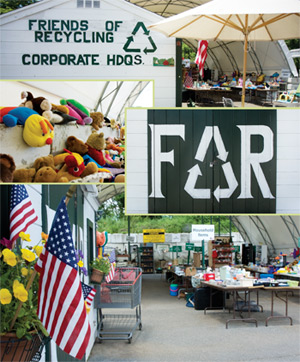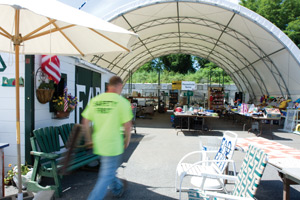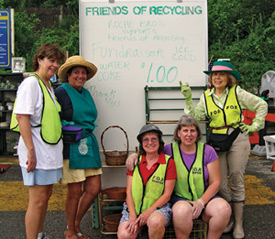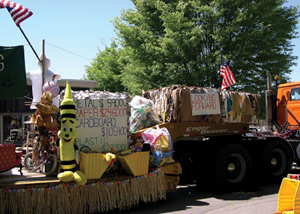Wellesley and Weston – Reduce, Reuse, Recycle
Carolyn S. Ellis writer
Matthew Burdick photographer
 Who would believe twelve miles from Downtown Boston in two of the most affluent towns in Massachusetts, residents cheerfully line up on Saturdays to recycle and dispose of their household waste? “It’s a point of pride to take your stuff to the dump,” says Weston resident Bill Symonds. “Everyone does it.” Motivated by concern for the planet and a sense of individual responsibility, Wellesley and Weston residents sort, rinse, deposit, and share recyclable and reusable items.
Who would believe twelve miles from Downtown Boston in two of the most affluent towns in Massachusetts, residents cheerfully line up on Saturdays to recycle and dispose of their household waste? “It’s a point of pride to take your stuff to the dump,” says Weston resident Bill Symonds. “Everyone does it.” Motivated by concern for the planet and a sense of individual responsibility, Wellesley and Weston residents sort, rinse, deposit, and share recyclable and reusable items.
Friends of Recycling
In the mid-1980s, Frank Hays and Jim Olsen joined forces to establish Wellesley’s Friends of Recycling (FOR), a not-for-profit that promotes awareness of the 3 R’s: Reduce, Reuse, Recycle. Wellesley’s Department of Public Works (DPW) director then was Pat Berdan, who as a World War II Navy veteran had witnessed how recycling had helped the war effort. Today FOR continues to educate and build awareness in the community while supporting reuse at Wellesley’s RDF, the Recycling and Disposal Facility of the Department of Public Works. Located at 199 Great Plain Avenue, the RDF welcomes Wellesley residents with colorful signage and a loop layout that brings visitors first to the recycling bays, then to the Reusables Area and other specialized drop-off sections, and finally to disposal.
“Recycling is one of my passions,” says FOR president Frank Hays. “With very little effort, people can make a difference. Wellesley is on the map in waste management around the world, with visitors from China, Japan, and Europe.” With FOR, recycling is fun. FOR has held recycling fairs with a flea market, music, and booths, and has created floats made entirely from RDF items for Wellesley’s Wonderful Weekend Veterans’ Parade in 2007 and 2008. “Our holiday Yankee Swap is the best ever,” says Joany Sasso, FOR volunteer coordinator. “All gifts come from RDF reusables, and we have all year to hunt for the perfect item.”
Wellesley recycling requires detailed sorting within separate collection bins, a specific place, for example, for frosted or translucent plastic bottles, clear or colored plastic bottles, plastic non-bottles, and plastic bags. In the reuse section, metals are separated into aluminum, copper, and metal/light iron. Detailed signage shows samples of what is recyclable and which items are excluded, but there’s a learning curve in knowing what goes where. It’s important not to contaminate categories.
Take and Leave
In 2005, Wellesley DPW budget cuts targeted staff who maintained the reusables area and it had to close. Sasso proposed that townspeople organize themselves to staff “Take and Leave.” Now in its fifth season, FOR volunteers in shifts of two to six workers are present whenever the RDF is open. Saturdays are the busiest day of the week, when the RDF is open from 7:00 am until 4:45 pm.

Wellesley’s Friends of Recycling volunteers created floats made entirely from RDF items for Wellesley’s Wonderful Weekend Veterans’ Parades in 2007 and 2008.
Take and Leave is open to Wellesley residents with an RDF permit sticker. These require proof of residency but are free. “Our mission is to keep the area safe and coordinated and to be helpful to people coming to the Take and Leave,” Sasso says. “We work as a team with RDF staff; it’s very rewarding.”
Reusables include sporting goods, furniture, children’s toys and games, gardening tools, household items, and electronics including televisions and computers. FOR volunteers help townspeople with the guidelines, explaining, for example, that for health reasons mattresses and box springs have to be discarded. Sasso describes Take and Leave as “a mini-Home Depot.” Families come for parts for school projects, dorm or apartment furnishings, and baby furniture for visiting grandchildren. She says, “We have even saved toilets for a school theater production.”
Take and Leave is open rain or shine, April through November, and on the very first Saturday the tables are full. “You name it; we’ve had everything come in,” says Priscilla Messing, FOR marketing and data coordinator, as people arrive with items they have stored all winter. Three years ago the DPW installed a fabric roof structure to protect items from the weather. “Anything good doesn’t last long,” Sasso says.
Recycling Isn’t New
Throughout history, people have reused materials like metals, ash, and rags, especially when resources were scarce. Frugality may have characterized America through the mid-19th century, but more recently our tendency to acquire has been fueled by prosperity, abundant supplies of inexpensive goods, and built-in obsolescence. Municipal and industrial waste streams have grown in response. As environmental awareness blossomed in the 1970s and 1980s, citizen activists in Weston and Wellesley jumped into recycling and pressed town officials to give recycling an important place in the transfer stations coming online.

Wellesley’s Friends of Recycling volunteers work as a team with the RDF staff.
State and federal regulations have grown increasingly stringent. Recycling mandates apply to materials like newspapers, cardboard, glass, tin cans, rigid plastics, and yard waste. In 1983 Massachusetts implemented the Beverage Container Recovery Law, or “Bottle Bill,” that attached a five-cent per bottle deposit to the purchase of beer, soft drinks, and mineral water. An update of the Mass. Bottle Bill HB3515/SB 1480 that will impose a 10-cent deposit on today’s popular sport drinks, flavored teas, and bottled water is pending. To limit the contamination of land and water by the precipitation of mercury, items like glass thermometers, old thermostats, and fluorescent tubes must be deposited in a special section. Handle them very carefully so they don’t break! Both Wellesley and Weston offer a Hazardous Waste Day each spring when residents can dispose of items like pesticides, weed killers, and paint removers.
“We have a very unique municipal operation,” says Gordon Martin, superintendent of the Wellesley RDF. “Every community in Massachusetts recycles, but we make money.” Martin explains that while meeting state and federal laws, “We are able to get premium dollars on our sales of recyclables because we use a worldwide market and we cut out the middleman. In Fiscal Year 2008 we returned $760,000 to the General Fund and in Fiscal Year 2009, $719,000.” Sales revenues fluctuate with worldwide markets for various materials. “Just because we are a government agency doesn’t mean we can’t act like a business,” Martin continues. “We are successful because everyone is pulling in the same direction – voters, DPW staff and board, volunteers, and town officials.” Wellesley’s solid waste is trucked to Seneca, New York for disposal.
An Integral Part of the Community
Weston’s Solid Waste Transfer Station and Recycling Center opened in June 1994. Located on Church Street opposite the Kendall Green train station and adjoining the former landfill, Transfer Station planning and design dominated town politics for several years. Residents who had begun a recycling program at the landfill strongly advocated that the town make the new facility as friendly to recycling as it was to solid waste.

In addition to their daily activities, Wellesley’s Friends of Recycling volunteers host recycling fairs and other fun activities throughout the year.
The resulting loop layout permits one-stop access to areas for recycling, disposal, and reusables. Residents can “Giveaway and Takeaway” serviceable items at the Swap Shack, a small metal building donated by residents and maintained by Transfer Station staff. A sign asks visitors to limit shopping to ten minutes. On a typical visit, one might find vases, glassware, books, a computer monitor, suitcases, small appliances, stuffed animals, stainless flatware, and framed prints on the shelves. Clothing and shoes can be left in bins for Goodwill Industries or Planet Earth.
“My boys love the dump,” says Symonds. “It’s like a treasure hunt. Will was one year old when we moved to Weston. We’ve progressed from preschool things to hockey sticks, and now Will is rebuilding a computer he got there.” Bill and his wife Cathy Symonds require their two sons to help with recycling.
“I have lived all over and I have never seen a system like ours,” Symonds says. “It’s very New England.” Toronto, where they lived prior to Weston, had curbside recycling and trash pickup, a single source system that is credited with increasing overall recycling in municipalities by 30 percent. Cathy Symonds didn’t know what to expect when the seller of their Weston home told them, “You have to go to the dump!” She wondered if she would need big boots to wade through trash. Arriving at the transfer station, she was pleasantly surprised and, as a bonus, discovered the social aspect. “It’s such an integral part of the community,” Cathy Symonds says. “On Saturdays we have to wait to unload. We always see people we know.”
Weston’s Transfer Station is restricted to Town residents with permit stickers on their vehicles, either fee-paid for waste disposal or free for recycling. Permit sales offset operating costs. Weston uses E. L. Harvey, a solid waste and recycling management company, to transport and process materials collected. Solid waste is trucked to Millbury, Massachusetts to fuel a Wheelabrator waste-to-energy plant. E. L. Harvey sorts and processes the recyclables and distributes them to various markets, according to DPW foreman Bill O’Neill. In Fiscal Year 2009 the Weston Transfer Station processed 2,190 tons of solid waste and 1,556 tons of recycling. Approximately half of Weston’s 3,350 households use the Transfer Station. With the per ton cost about $60 less than solid waste to process, recycling in FY 2009 saved the Town of Weston more than $100,000.
 A Way of Life
A Way of Life
Campaigning at the Transfer Station is a must for local politicians, including former Weston Selectman Joe Mullin who served three terms and ran for Lieutenant Governor in 1994. When Joe and Madeline Mullin moved to Weston in 1979, residents tossed trash into a pit where a machine compacted and covered it. Gulls circled overhead, and when the dump burned, residents around town could smell the smoke and hear the fire department responding.
Mullin served on the Board of Selectmen from 1989 to 1998 when Weston was planning and building the transfer station. The process was complicated, requiring twenty-four permits, Mullin recalls. On balance he is happy with how things worked out. “We got a positive location for a difficult municipal function, benefited the City of Cambridge by cleaning up a problem we had created with their water supply, and we supplied an environmentally friendly procedure for disposal of solid waste plus got a recycling feature,” he says.
About half of Weston households use commercial haulers. Work schedules, weekends away, and children’s activities can make it difficult to visit the Transfer Station regularly. However, for Dave Hutcheson of Weston and his family, recycling is a way of life. Dave says he dislikes messiness and waste and makes several visits a week with items he picks walking about town. His daughter Marguerite Hutcheson was active in Students for Environmental Action (SEA) at Weston High School. Brandon Blaesser and Jayme O’Laughlin are co-presidents of SEA today.
SEA recently collected 200 pairs of sneakers for Nike’s Reuse-A-Shoe program in which athletic shoes are ground to produce Nike Grind sport and play surfaces. SEA also conducted a binder swap. “It’s easier for kids to join in when they see things changing,” Blaesser says. “Some want to save the planet and others want to design customized water bottles that kids will want to carry.” Blaesser, age 17, recently passed the Green Building accreditation exam to become a Leadership in Energy and Environmental Design Accredited Professional (LEED AP).

Friends of Recycling floats for Wellesley’s Wonderful Weekend parade.
Beverage containers and paper are recycled at the high school under an initiative instituted by past superintendent Alan Oliff and current superintendent Cheryl Maloney. Classrooms have bins for both, and SEA and other students rinse hundreds of bottles and cans. “It takes a certain amount of dedication,” says Weston High biology teacher Janet Kresl Moffat, chairman of the Weston District Green Team. “If it’s not something that people think makes a difference, they’re not going to do it. At some level you have to believe in the correctness of recycling.” In 2009 school recycling efforts diverted 121 tons from solid waste, Moffat notes. She is a supporter of the updated Bottle Bill.
The economic downturn of 2008 resulted in the production of less solid waste and fewer recyclables. At the reusable areas, staff reports more shoppers, especially younger families, and fewer new, unopened items. “Perhaps people are using eBay to sell these now,” says Olsen, FOR chairman. Recycling rates in both towns seem to have reached a plateau. Wellesley has instituted the Step Up! Program to encourage everyone to bring his or her recycling up one notch. It’s important to remember that recycling is voluntary, and residents make the difference. “You can never recycle enough,” Weston DPW director of operations Bob Hoffman says.
Some say the amount we are recycling is a tiny fraction of all the municipal, commercial, and industrial waste produced in our nation and around the globe. But Joany Sasso cites the delight on children’s faces when, new to Wellesley’s Take and Leave, they ask, “How much is this?” and are told, “You can take it.” ![]()
© 2010 Elm Bank Media | Beth Furman, Publisher | Beth@ElmBankMedia.com


recent comments